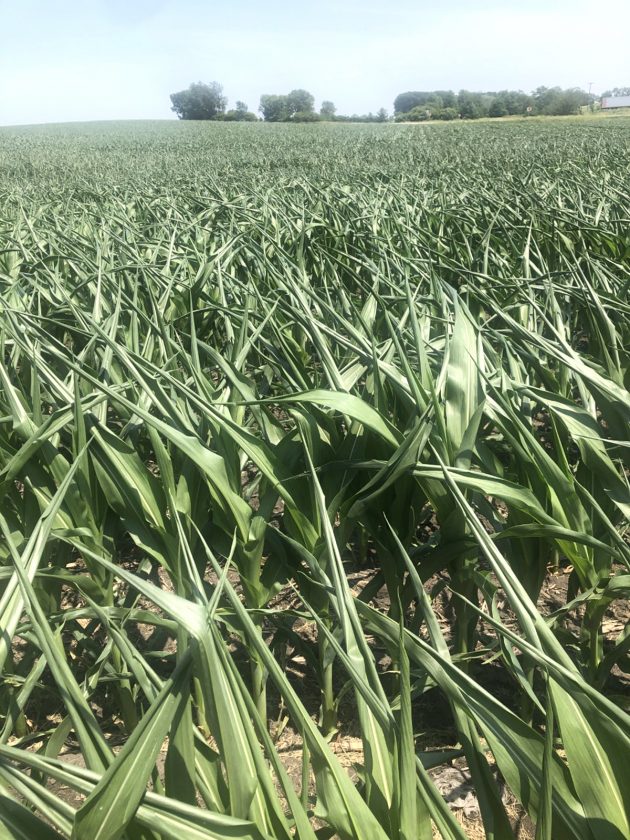Drought impact extends beyond fields
-
-Submitted graphic
The most recent drought monitor, which was released Thursday by the U.S. Drought Monitor, shows conditions worsening with a larger area now being labeled “D2” a severe drought.
-
-Submitted photo
Corn plants show extreme stress due to high heat and a lack of moisture. This particular field is located east of Clarion. Angie Rieck-Hinz, Iowa State University Extension and Outreach field agronomist said although this corn crop is suffering, this is actually not the worse she has seen.

-Submitted graphic
The most recent drought monitor, which was released Thursday by the U.S. Drought Monitor, shows conditions worsening with a larger area now being labeled “D2” a severe drought.
The lingering drought has affects that are felt far away from the dry farm fields, according to experts.
The price of corn and soybeans have definitely seen an upward price movement and the drought is a strong push behind that.
“As we look at conditions across the state, they have been worsening over the course of the past couple of months and the markets react to that,” said Chad Hart, ISU Extension and Outreach agricultural economist. “We have put some of the best prices that we have seen in basically over a decade on the board this year because of the concern of how big the drought impact could be.”
How will this impact the farmer?
Hart said it may not impact them as negatively as one would think.

-Submitted photo
Corn plants show extreme stress due to high heat and a lack of moisture. This particular field is located east of Clarion. Angie Rieck-Hinz, Iowa State University Extension and Outreach field agronomist said although this corn crop is suffering, this is actually not the worse she has seen.
“When you look back at previous droughts what we actually found is prices tend to rise more than yields go down,” he said. “What that means, in general is drought years tend to be higher income years because of that. It is counterintuitive.”
This may not be true for every producer, however.
The farmers that are in the heart of a natural disaster, such as a drought, Hart said, are the ones that are most financially impacted in a negative manner.
It is situations like this, Hart said, that have led to a strong safety net being built up through crop insurance.
“There are a lot of programs set up for agriculture that are meant to help farmers when they are facing different stresses – especially when it comes to things like drought,” he said. “That is why we have things like crop insurance to help those individuals out while maybe the rest of agriculture is doing better. You are going to see that style of government support kick in to help offset some of the financial impact of the drought for the most impacted farmers.”
Regardless of what aid may become available for producers this year, it is not what they are after. A drought, Hart said is a very challenging, emotionally stressful time.
“Farmers know financially it should work out for them, but it is the challenge of I planted this crop to grow it, not to watch it not grow. Not to watch it get destroyed. Not to watch it fade away,” he said. “There is the emotional attachment that is hard to block.”
What can a widespread drought mean for the consumer?
Hart said even in these times, consumers should not expect much of a change at the grocery store.
A misconception many have is they think the bill they pay at the store is more related to the farm prices than it actually is.
“When we think about what we have seen in corn and soybean prices over the past year, they have basically doubled, but you are not seeing that type of pricing pressure at the grocery store,” he said. “We may have seen prices go up, but they haven’t doubled.”
In fact, Hart said that of a dollar that is spent at the grocery store, only about 15-cents goes back to pay for the farm product.
“What that tells you is the vast majority of the cost at that grocery store is not what is happening on the farm,” he said. “What it does mean is that it significantly reduces the consumer risk when farm prices change.”
There is a little more of a connection to the consumer and the farmer producing livestock, however.
Hart estimates it is anywhere from 30 percent to 50 percent of the dollar spent at the grocery store on meat that goes back to buy the animals on the farm.
The drought potentially could have an impact on meat prices – but in a different way than one might expect.
“Drought conditions, if they are strong enough and last long enough, they might force some cattle producers to go ahead and liquidate some cattle early,” he said. “That will mean there will be a lot of cows searching for slaughter plants and that will drop the price of cattle and will actually lower the price of beef because we would be putting a lot more beef on the market at one time compared to usual. Instead of driving prices up, it could drive meat prices down if we do see some herd liquidation out there.”








